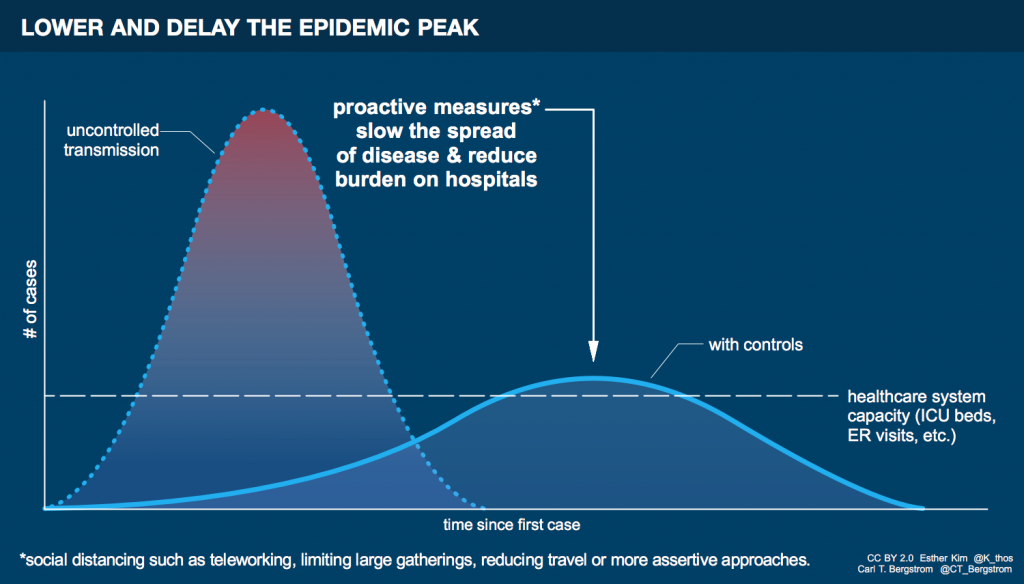Why Flattening The Curve Matters
Mayor Tom Barrett lays out how Wisconsin could be short by 56,000 hospital beds.

Flatten the curve graphic. Esther Kim & Carl T. Bergstrom. (CC BY)
In the past two weeks, a lot has been made of “flattening the curve” — the public health strategy to slow the spread of COVID-19 and, most importantly, preserve capacity within hospitals to treat those that need it.
“Our hospitals are busy. They always operate at a high level,” said Dr. Ben Weston, director of medical services for Milwaukee County, during a briefing on the city and county’s pandemic response.
Mayor Tom Barrett added numbers to Weston’s claim, and then extrapolated them out.
There are approximately 12,000 hospital beds in the state and at any time 8,000 are filled, said Barrett.
Barrett noted there are six million people in Wisconsin (2010 census: 5.68 million) and if only 10 percent of the population got the disease, that would leave 600,000 with COVID-19. Approximately 10 percent of them would need to be hospitalized according to figures shared by the state earlier Monday.
“That’s why what we’re talking about is so important,” said Barrett of the need to practice social distancing (staying home when possible, staying six feet away from others). If that same number of people got infected over a longer period of time it would save lives by preserving hospital beds.
Have the city and state waited too long to issue a “stay at home” order?
“It’s hard to say,” said Milwaukee Health Commissioner Jeanette Kowalik. “Us issuing these this week, this is a good time.” She said waiting until next week could be too late.
Slowing the spread of the disease by isolating people is intended to preserve hospital capacity. “Our goal, as we all recognize, is to encourage people to stay home, so please stay home,” said Barrett.
But Barrett and Kowalik both raised concerns Monday that the message isn’t being received across the city. A map of cases in Milwaukee County shows that the bulk of the 158 cases in the city are clustered in predominantly black neighborhoods on the city’s far northwest side.
“It’s middle-aged African American men who are the majority of cases in the city,” said Kowalik. But, as Barrett, Kowalik and other public health officials have repeatedly stressed, the disease doesn’t discriminate. Ticking off a list of negative health factors, including poverty and redlining Kowalik said, “Seeing COVID-19 cases in certain parts of the community, it kind of mirrors those other health factors, which shows that there are disparities.”
If you think stories like this are important, become a member of Urban Milwaukee and help support real, independent journalism. Plus you get some cool added benefits.
More about the Coronavirus Pandemic
- Governors Tony Evers, JB Pritzker, Tim Walz, and Gretchen Whitmer Issue a Joint Statement Concerning Reports that Donald Trump Gave Russian Dictator Putin American COVID-19 Supplies - Gov. Tony Evers - Oct 11th, 2024
- MHD Release: Milwaukee Health Department Launches COVID-19 Wastewater Testing Dashboard - City of Milwaukee Health Department - Jan 23rd, 2024
- Milwaukee County Announces New Policies Related to COVID-19 Pandemic - County Executive David Crowley - May 9th, 2023
- DHS Details End of Emergency COVID-19 Response - Wisconsin Department of Health Services - Apr 26th, 2023
- Milwaukee Health Department Announces Upcoming Changes to COVID-19 Services - City of Milwaukee Health Department - Mar 17th, 2023
- Fitzgerald Applauds Passage of COVID-19 Origin Act - U.S. Rep. Scott Fitzgerald - Mar 10th, 2023
- DHS Expands Free COVID-19 Testing Program - Wisconsin Department of Health Services - Feb 10th, 2023
- MKE County: COVID-19 Hospitalizations Rising - Graham Kilmer - Jan 16th, 2023
- Not Enough Getting Bivalent Booster Shots, State Health Officials Warn - Gaby Vinick - Dec 26th, 2022
- Nearly All Wisconsinites Age 6 Months and Older Now Eligible for Updated COVID-19 Vaccine - Wisconsin Department of Health Services - Dec 15th, 2022
Read more about Coronavirus Pandemic here





















It is critical to emphasize that the cluster of covid-19 on Milwaukee’s north side and middle aged African American men is not a result of that community refusing to social distance. It is rather the result of decades of racist policies that have created critical health disparities. A major result of rampant racism in Milwaukee is the increased vulnerability to optimistic viruses in communities of color.